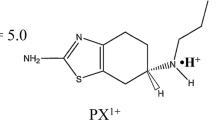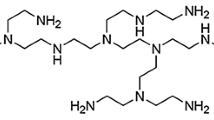Abstract
Purpose. To identify and quantify, in vitro and in vivo (in humans), the charge-carrying species during transdermal iontophoresis of lidocaine hydrochloride as a function of the concentration of drug relative to that of sodium chloride in the anodal solution.
Methods. In vitro experiments in standard diffusion cells quantified lidocaine delivery and the outward migration of chloride across the skin. Electrotransport of Na+ was inferred by difference, allowing transport numbers of the three main charge-carrying species to be deduced. In vivo, outward electrotransport of Cl− was measured and compared to the corresponding in vitro results.
Results. The transport number of lidocaine increased linearly with increasing mole fraction and reached 0.15-0.20 at XL = 1.0. In the absence of Na+, most of the charge was carried by Cl− (>80%) despite the skin retaining its net negative charge and cation permselectivity. In vivo data correlated very well with in vitro results.
Conclusions. The mole faction of drug (relative to competing ions of like polarity) is the crucial determinant of the extent to which it can carry charge across the skin during iontophoresis. The outward electromigration of Cl−, in the sense opposite to drug delivery, may offer a useful means by which to optimize iontophoretic efficiency in the absence of competing cations in the anode formulation.
Similar content being viewed by others
REFERENCES
R. R. Burnette. Iontophoresis. In J. Hadgraft, and R. H. Guy (eds.), Transdermal Drug Delivery. Marcel Dekker, Inc., New York, 1989, pp. 274-291.
B. H. Sage and J. E. Riviere. Model systems in iontophoresis—transport efficacy. Adv. Drug Deliv. Rev. 9:265-282 (1992).
R. R. Burnette and B. Ongpipattanakul. Characterization of the permselective properties of excised human skin during iontophoresis. J. Pharm. Sci. 76:765-773 (1987).
D. Marro, Y. N. Kalia, M. B. Delgado-Charro, and R. H. Guy. Contributions of electromigration and electroosmosis to iontophoretic drug delivery. Pharm. Res. (2001) In press.
D. C. Harris. Quantitative Chemical Analysis, 2nd Edn. Freeman and Co., New York, 1987.
J. B. Phipps and J. R. Gyory. Transdermal ion migration. Adv. Drug Deliv. Rev. 9:137-176 (1992).
R. V. Padmanabhan, J. B. Phipps, and G. A. Lattin. In vitro and in vivo evaluation of transdermal iontophoretic delivery of hydromorphone. J. Control. Release 11:123-135 (1990).
B. H. Sage. Iontophoresis. In E. W. Smith and H. I. Maibach (Eds.), Percutaneous Penetration Enhancers. CRC Press, Inc., Boca Raton, Florida, 1995, pp. 351-368.
G. B. Kasting and J. C. Keister. Application of electrodiffusion theory for a homogeneous membrane to iontophoretic transport through skin. J. Control. Release 8:195-210 (1989).
Author information
Authors and Affiliations
Rights and permissions
About this article
Cite this article
Marro, D., Kalia, Y.N., Delgado-Charro, M.B. et al. Optimizing Iontophoretic Drug Delivery: Identification and Distribution of the Charge-Carrying Species. Pharm Res 18, 1709–1713 (2001). https://doi.org/10.1023/A:1013370529366
Issue Date:
DOI: https://doi.org/10.1023/A:1013370529366




